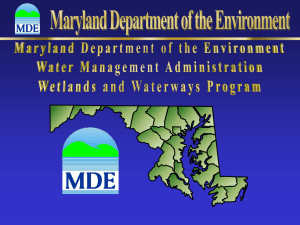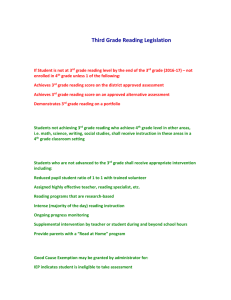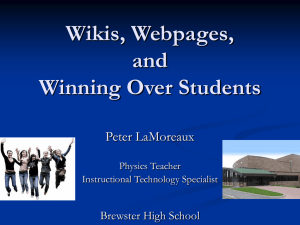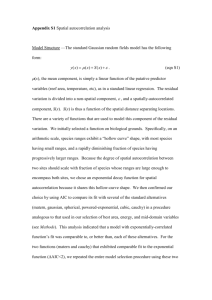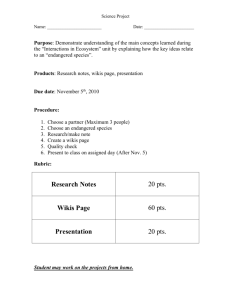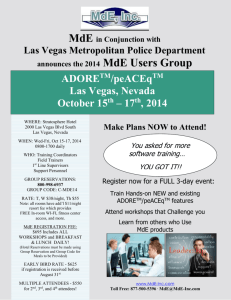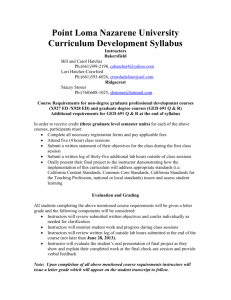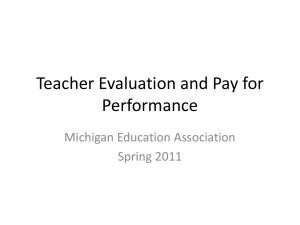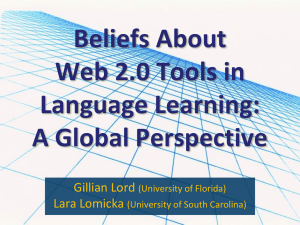Assessing the added value of Web 2.0 tools for e
advertisement
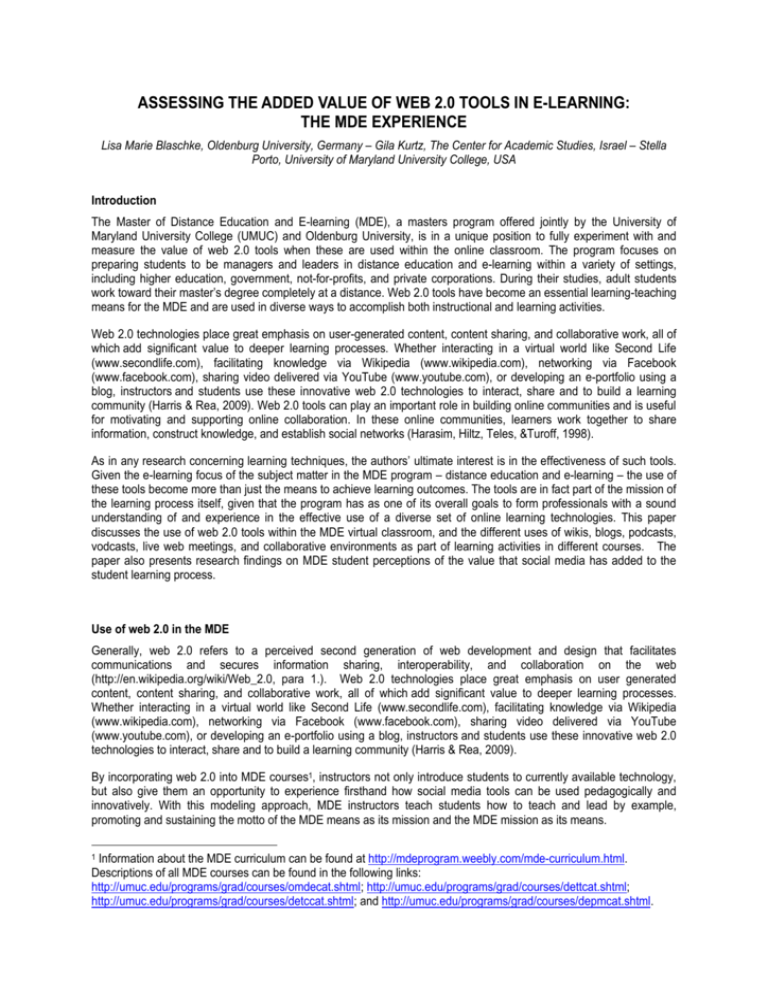
ASSESSING THE ADDED VALUE OF WEB 2.0 TOOLS IN E-LEARNING: THE MDE EXPERIENCE Lisa Marie Blaschke, Oldenburg University, Germany – Gila Kurtz, The Center for Academic Studies, Israel – Stella Porto, University of Maryland University College, USA Introduction The Master of Distance Education and E-learning (MDE), a masters program offered jointly by the University of Maryland University College (UMUC) and Oldenburg University, is in a unique position to fully experiment with and measure the value of web 2.0 tools when these are used within the online classroom. The program focuses on preparing students to be managers and leaders in distance education and e-learning within a variety of settings, including higher education, government, not-for-profits, and private corporations. During their studies, adult students work toward their master’s degree completely at a distance. Web 2.0 tools have become an essential learning-teaching means for the MDE and are used in diverse ways to accomplish both instructional and learning activities. Web 2.0 technologies place great emphasis on user-generated content, content sharing, and collaborative work, all of which add significant value to deeper learning processes. Whether interacting in a virtual world like Second Life (www.secondlife.com), facilitating knowledge via Wikipedia (www.wikipedia.com), networking via Facebook (www.facebook.com), sharing video delivered via YouTube (www.youtube.com), or developing an e-portfolio using a blog, instructors and students use these innovative web 2.0 technologies to interact, share and to build a learning community (Harris & Rea, 2009). Web 2.0 tools can play an important role in building online communities and is useful for motivating and supporting online collaboration. In these online communities, learners work together to share information, construct knowledge, and establish social networks (Harasim, Hiltz, Teles, &Turoff, 1998). As in any research concerning learning techniques, the authors’ ultimate interest is in the effectiveness of such tools. Given the e-learning focus of the subject matter in the MDE program – distance education and e-learning – the use of these tools become more than just the means to achieve learning outcomes. The tools are in fact part of the mission of the learning process itself, given that the program has as one of its overall goals to form professionals with a sound understanding of and experience in the effective use of a diverse set of online learning technologies. This paper discusses the use of web 2.0 tools within the MDE virtual classroom, and the different uses of wikis, blogs, podcasts, vodcasts, live web meetings, and collaborative environments as part of learning activities in different courses. The paper also presents research findings on MDE student perceptions of the value that social media has added to the student learning process. Use of web 2.0 in the MDE Generally, web 2.0 refers to a perceived second generation of web development and design that facilitates communications and secures information sharing, interoperability, and collaboration on the web (http://en.wikipedia.org/wiki/Web_2.0, para 1.). Web 2.0 technologies place great emphasis on user generated content, content sharing, and collaborative work, all of which add significant value to deeper learning processes. Whether interacting in a virtual world like Second Life (www.secondlife.com), facilitating knowledge via Wikipedia (www.wikipedia.com), networking via Facebook (www.facebook.com), sharing video delivered via YouTube (www.youtube.com), or developing an e-portfolio using a blog, instructors and students use these innovative web 2.0 technologies to interact, share and to build a learning community (Harris & Rea, 2009). By incorporating web 2.0 into MDE courses1, instructors not only introduce students to currently available technology, but also give them an opportunity to experience firsthand how social media tools can be used pedagogically and innovatively. With this modeling approach, MDE instructors teach students how to teach and lead by example, promoting and sustaining the motto of the MDE means as its mission and the MDE mission as its means. Information about the MDE curriculum can be found at http://mdeprogram.weebly.com/mde-curriculum.html. Descriptions of all MDE courses can be found in the following links: http://umuc.edu/programs/grad/courses/omdecat.shtml; http://umuc.edu/programs/grad/courses/dettcat.shtml; http://umuc.edu/programs/grad/courses/detccat.shtml; and http://umuc.edu/programs/grad/courses/depmcat.shtml. 1 Incorporating the web 2.0 concept into online teaching helps elicit learner participation beyond standard textual responses and enables instructors to engage students as interactive learners in a way that has been nearly impossible up to now. In fact, using social media can help students create for themselves new contexts for learning and communication. As Harris & Rea (2009) stated: "Students become part of the lesson"! (p.141) To maximize these interaction levels, web 2.0 tools are utilized for a variety of purposes within the MDE classroom (Table 1). Table 1 Examples of web 2.0 within the MDE Classroom Type of tool Textual, audio and video Live and recorded sessions Wikis Blogs Document sharing Uses Project management, document sharing and discussion, information distribution and visual presentation, student feedback Information distribution and visual presentation, discussion Project management, document sharing, discussion, information gathering, student interaction Information distribution and sharing, student feedback, student interaction Student feedback ("coaching"), information gathering and sharing The following sections discuss how MDE instructors use these web 2.0 tools within the MDE classroom. Textual, audio and video, live and recorded sessions Instant Messaging In an online, asynchronous environment, students may feel lost out in cyberspace. Within the MDE classroom, synchronous instant messaging (IM) functionality is built into the WebTycho platform, UMUC's proprietary LMS (www.tychousa.umuc.edu/). Students use the IM function to maintain contact with each other and the instructor, to discuss course content, establish frameworks for course projects (e.g., project schedule, responsibilities, action items, and due dates), and to discuss feedback on course assignments. Instructors use the IM function to provide feedback on assignments and student performance, as well as to keep lines of communication open with students. The IM function, together with the classroom awareness function, allows instructors to easily strike up a conversation at any time with any student who is online---and vice versa. This immediate feedback supports the individual learning process. Audio MDE instructors use audio in the form of podcasts and voice boards (e.g., www.wimba.com). Within OMDE 6012, audio files are used to introduce students to the classroom environment, as well as to course content. Audio has also been used as a form of advance organizer, providing students with an overview of module and/or course content (Holmberg, 2005). These audio introductions make instructors and visiting experts more familiar to students and help students "put a voice" to the instructor/expert with whom they are interacting. Video As a standard feature of OMDE 6033, instructors purposefully guide students' use of social media applications to facilitate their multimedia skill development. Podcasts, either generated by students or by instructors, have been used to help share multimedia knowledge and information (Bonk, 2008). To support this effort, instructors have created audio tutorials and use sites such as YouTube and Teacher Tube (www.teachertube.com) to post lessons for easy student access. Live and Recorded Classroom Sessions The inclusion of synchronous instruction helps in creating a greatly enhanced teaching and learning experience through active engagement and spontaneous exchanges (Agosti et al, 2006). Within OMDE 601, instructors use Wimba Live Classroom (www.wimba.com/products/wimba_classroom/), for example, to present course content and to 2Foundations 3Technology of Distance Education and E-learning in Distance Education and E-learning introduce and discuss class-related topics, activities, and assignments. The Wimba Live Classroom session is synchronous and incorporates graphics, application sharing, audio, video, and chat. The sessions can also be recorded so that students have the choice of visiting the sessions synchronously or asynchronously. Within OMDE 603 and DETC 6304, instructors also use live audio and video meetings to discuss topics relevant to courses. For example, we conduct live discussions on the digital divide using Wimba. Wikis Social media plays an important role in building online community and is useful for motivating and supporting online collaboration. In these online communities, learners work together to share information, construct knowledge, and establish social networks (Harasim, Hiltz, Teles, &Turoff, 1998). Wikis can be used in the online setting to facilitate building shared knowledge among and by students (Meishar-Tal, Tal-Elhasid, &Yair, 2008). Students perceive wikis as positively supporting collaboration efforts and effectively supporting learning and engagement (Hughes & Narayan 2009; Kurtz & Bar-Ilan, 2010). In OMDE 603, students are asked to work in a wiki as a group to create an annotated class glossary of DE terms relevant to the course. Each group of students chooses one term to contribute to the glossary. This is an ongoing activity as students can choose any term that they like as long as it is relevant to the course and has not been contributed in earlier classes. This way past and present collaborative knowledge is combined. In addition to using wikis for collaborating on coursework, students provide feedback to each other on the student wiki content, including the navigation and structure of wiki. This only occurs, however, when a student is invited to the wiki by the wiki's creator. Instructors also post feedback to students directly into the wiki, for example, as a response to an entry in the wiki and/or within the discussion area of the wiki page. A cornerstone of the MDE program is the e-portfolio. Although this activity is only fully assessed at the end of the program during the capstone course (OMDE 670), many students create a wiki at the start of the program, and these wikis become the home of their e-portfolios. The e-portfolio is an evolving student creation, and as the MDE student progresses through the MDE program, the student uses the e-portfolio to capture and store experiences, reflections, and artifacts (Porto and Walti, 2008). In OMDE 601, the first course for newly registered MDE graduate students, instructors initially introduce students to the wiki and the e-portfolio. Students identify their personal requirements (or desired features) for the wiki, and each student maintains an individual, reflective learning journal within the wiki. By incorporating online learning journals as wikis, students are introduced to web 2.0 technology while being encouraged to think critically and reflectively about what they have learned within the course. Completion of a personal learning journal is done by each student, and students are encouraged to expand upon their learning journal wikis with each course of their graduate program--continuously reflecting on their learning experiences and the knowledge they have gained through their experiences. In OMDE 6705 and DETC 6306, the instructors use a class wiki for all the information concerning the course syllabus and details on how to submit assignments. The wiki facilitates the access and organizing the information, in a way that the LMS does not. In the case of DETC 630, the course also has students using several of the technologies discussed in this paper as sandboxes for the development of their own learning module prototype. In the case of OMDE 670, the course wiki serves the purpose of providing information about e-portfolio and the research project to all MDE students, which supports these activities for students that are not yet in the capstone course, but are working on their e-portfolios throughout the program. This course wiki is also used during program orientations that take place during the second week of every term. Each course is a building block within the learner experience. Together, the MDE courses create a continuum of each student's personal and professional development while in the MDE program. The student's continuous work on the eportfolio ultimately serves as the basis for the student's final MDE capstone project. During the capstone project, the student is required to submit both a research project and the final version of his or her e-portfolio. It is this e-portfolio that the students take with them into the professional work environment as evidence of student accomplishments Blogs 4Synchronous 5Portfolio and Asynchronous Learning Systems in Distance Education and Project in Distance Education 6Synchronous and Asynchronous Learning Systems in Distance Education and E-learning Blogs, as online journals, serve the purpose of allowing students to process and personalize information. Ideally, longterm blog assignments allow students to take charge of their own learning, and they eventually develop into independent lifelong learners (Pang, 2009). Blogging has also been found to reduce students' sense of isolation and increase their feelings of connectedness (Wolf, 2008). In addition, blogging can support student reflection, as well as writing style development (Pulman, 2007). Within OMDE 603, students are asked to create a blog (textual or video) as their second course assignment. The purpose of this ongoing six-week activity is for students to reflect on their personal viewpoints regarding the course readings and their ideas related to the class. They are also asked to write or record blog posts about topics not covered in class discussions or other activities. Each student is assigned a critical friend (a fellow classmate) to give feedback on the student’s posts. The last blog posting is a reflection on the critical friend activity. Document sharing Document sharing allows students to collaborate in the development and construction of knowledge. Students use free web applications, such as Google Docs (www.docs.google.com/) and Adobe Buzzword (https://www.adobe.com/acom/buzzword/), to share documents and to simultaneously edit and discuss (using chat and/or audio) document content. The ability to share and discuss course assignments synchronously and asynchronously supports students not only in information sharing, but also in constructing new knowledge. Within the OMDE 670 (Capstone course), instructors also use document sharing applications to collaborate with students on their final research projects. Using document sharing allows instructors to track student progress without invading their privacy and helps instructors ensure that important project milestones are met along the way. Document sharing also supports in synchronous assessment of work, specifically in providing the student guidance in improving his or her research project. The student invites an instructor to his or her document, and the instructor works together with the student online in reviewing the research project content and progress. Document sharing is also used asynchronously, with instructors providing context-specific feedback to the student work using document commenting functionality. Within OMDE 603, document sharing is mainly used for administrative purposes. For example, students share their blog URLs in Google Docs and register for synchronous activities. Measuring student perceptions Clearly, the MDE program has implemented a wide array of social media within its courses. As with the implementation of any technology in the classroom, an important consideration is the pedagogical effect that these tools have on students. Do social media tools add value to the learning experience? And if so, in what way do these tools add value? Design and procedure When conducting this research project, the authors used an online survey to ask students about the perceived pedagogical value of five different forms of media: blogs, wikis, audio/podcasts, video, and live classroom. In addition, the survey also asked students to rate the difficulty of using the media, in order to establish tool aptitude and perceived competency in using the tool (Hazari, North, & Moreland, 2009). Survey items were structured and closed-ended, represented by 5-point Likert scale ranging from 1 (strongly agree) to 5 (strongly disagree) and included a ‘did not use’ option. The authors’ research was meant to measure students’ perceptions of the pedagogical value added by the social media tool by asking students to rate statements such as those in the following table for each web 2.0 tool (Table 2). Table 2 Measuring Pedagogical Value Pedagogical Dimensions Connectivity (student-instructor, studentstudent, student-content) Statement (strongly agree, agree, neutral, disagree, strongly disagree) Made me feel more connected to the instructor Made me feel more connected to other students Made me feel more connected to the course content Promoted collaboration between me and my classmates (wikis, blogs only) Helped me better understand course material Comprehension Meta-cognition Made me further reflect on what I had read and/or experienced in class Gave me a better understanding my personal learning process Made me think about how I think Enabled me to create new content According to Lee & McLoughlin (2010) key affordances of web 2.0 tools help to create an environment that supports participation and communication, while supporting distance education students develop “essential core skills needed for lifelong learning, such as self-directed learning, knowledge creation, and digital literacy” (p. 73). They identify key affordances of social software tools as: Connectivity and social rapport: supports the creation of people networks Collaborative information discovery/sharing: enables data sharing among learners (e.g., social bookmarking) Content creation: supports learners in creating new content as opposed to consuming content Knowledge and information aggregation and content modification: supports learners in collection and customization of available information for personal use (p. 667). The measures applied through the surveys do not explicitly reflect these key affordances, but the pedagogical dimensions surveyed are closely related (for example, connectivity and content creation). Another consideration was the analysis of both the use of social media for content creation (active) and/or for student consumption (passive use). According to Weisberger (as cited in the Educational-portal blog, 2010), only 10-12% of professors using social media use it for active purposes, such as learner-generated content creation. Therefore, it was of interest to learn about and understand students’ perceptions concerning their learning when the tools are used actively (blogs and wikis) or passively (audio/podcasts, video and live-classrooms7). Participants Students from two distinct MDE courses were selected to be surveyed as the basis for the research, primarily due to their established and consistent use of social media (over one year – 3 terms per year): Within OMDE601, the survey was conducted for four sessions of the course running from 2009 to 2010. The survey was distributed to fifty-four (N=54) students, with 18 students completing the survey (33.3% percent). Social media use surveyed included wikis, audio/podcasts, video, and live meeting. Within OMDE603, the survey was conducted for two sessions of the course running from 2009 to 2010. The survey was distributed to thirty-seven (N=37) students with 14 students completing the survey (37.8%) Social media use surveyed included wikis, blogs, audio/podcasts, video, and live meeting. Results/findings In general, students found that use of social media supported them in their learning processes and helped them acquiring skills in using new tools, skills that they did not have prior to the class and that will be helpful to them in practical application in the work environment. Connectivity (or interaction), comprehension, and meta-cognition are the three dimensions that were measured in order to estimate the perceived pedagogical value of web 2.0 (Table 2). In addition to being surveyed regarding their perceptions on the pedagogical value of web 2.0 social media, students were also asked to rate the difficulty of using Although live-classrooms are identified here as ‘passive’ tools, students were required to be able to login and use the whiteboard during a few of the live sessions. Nonetheless, the authors did not consider this to be significant, and have therefore classified the use of the tool as passive within this context. 7 social media tools. Blogs and wikis were considered very easy to use for most students. In the case of videos, students were not required to create videos, so viewing the videos was not considered a difficult task. The development of wikis and participation in live sessions were the activities that posed the most difficulty. Interaction and connectivity Figure 1 presents the percentage of students who agreed or strongly agreed with the usefulness of each web 2.0 tool to promote interaction with instructor, other students and course content. Wimba (www.wimba.com) refers to the live classroom software used for delivering and recording live and recorded classroom sessions at UMUC. Figure 1 – Connectivity: Student-instructor, student-student, student-content In terms of connectivity, students generally found that social media supported them in connecting with the instructor, students, and course material. The level of connection varied, however, depending on the type of media and type of connection. For example, students felt strongly that Video/YouTube connected them to content (100%), but did not feel that it strongly connected them to the instructor (68%). Audio/podcasts helped students feel more connected to the instructor (93%) and to the content (100%), but not strongly to other students (53%). Wimba (Live Classroom) was the only media that students felt strongly connected them to instructors, students, and course content. Said one student in the survey: “I really enjoyed talking to the faculty and fellow students through the use of Wimba. It was nice to get to know people in the class, especially, in the online setting since you really don't know who is who.” These observations should be considered carefully, however, since for distance students the effect of having the opportunity of synchronous contact is a significant break from the common pattern of asynchronous text-based communication. The survey captures students’ perceived sense of closeness, but these cannot be realistically considered a measure of improved learning. Nonetheless, students’ psychological perceptions of increased connectivity could positively influence students’ motivation and the potential for enhanced learning. Comprehension Student comprehension was the next area in which data was gathered on students’ perceptions. The statement posed was: “The use of [media] helped me better understand course material.” As Figure 2 shows, blogs and videos strongly supported student comprehension of course content (over 90% of students agreeing with the statement). Audio/podcasts and wikis were not perceived as strongly promoting student understanding of content, but still had a high portion of 75% with students agreeing with the statement. The live classroom generally supported student understanding of content (86% of students in agreement). Figure 2 – Comprehension: Understanding of course content Meta-cognition Figure 3 presents the percentage of students who agreed or strongly agreed with usefulness of each web 2.0 tool to increase meta-cognition, e.g., helping to understand how one thinks and to prompt further reflection. Figure 3 – Meta-cognition: Reflection on content/experiences, personal learning and thinking processes In terms of collaborative information discovery and sharing, students’ perceptions were that both blogs and wikis promoted collaboration. Students also perceived that blogs and wikis better enabled them to create content, with one student commenting that wikis “helped me organize my thoughts, make connections and gave me the opportunity to share my work with both the instructors and other students of choice” (MDE student). Another student responded that s/he was not impressed with social media tools in relation to classroom learning and his/her learning process, preferring instead the face-to-face classroom setting – which illustrates how using the tool influenced the student in thinking about and understanding his/her preferred learning process. A key influential factor seems to be how the social media are actually used within the classroom. For example, within OMDE603, wikis are used by groups of students to collaborate together in creating learner-generated content (definitions). Within OMDE601, however, wikis are used by individual students to create e-portfolios and to store reflective learning journals – and not for collaboration purposes. This difference in how wikis were used could also influence why students perceived that wikis did not strongly promote collaboration or connectivity with other students (in OMDE601). Active versus passive use of social media Another consideration when evaluating the research results was student perceptions of the social media depending on whether the media was used for content creation (active) or for student consumption (passive use). In the classrooms studied, social media were used as shown in Table 3. Table 3 Use Active/passive use of media in studied classrooms Social media Passive (consumption Audio/podcast, video/YouTube, Live Classroom (Wimba) only) Active (learner- Wikis, blogs generated content) Figure 4 shows student agreement (strongly agree and agree) with the survey statements, according to whether the media was used passively or actively in the classroom. In assigning a value for passive use of the media, the mean of audio/podcast, video/YouTube, and Wimba (Live Classroom) was used. In assigning a value for active use, the mean of wikis and blogs was used. Figure 4 Student perceptions: Active vs. passive use of social media Substantial differences were found in terms of metacognitive activities. For example, active social media was more effective (from a student’s perspective) in terms of helping students better understanding their individual learning process (active: 90%, passive 73%) and helping students think about how they think (active: 87%, passive: 68%). There was also a difference in whether the media helped the student better reflect on course content (active: 95%, passive, 84%). In terms of helping students understand course content or feeling more connected to the course content, both uses of the media – active and passive – were similarly effective. Passive use of media made students feel more connected to instructors: 86% agreement (passive) as compared to 72% agreement (active). Active use of media, on the other hand, gave students a somewhat stronger perception of connectivity with other students (active: 76%; passive: 69%). Based on these findings, active use of social media, that is, students generating own content, creates a stronger student perception that metacognition is occurring. Passive use of social media also supports metacognition, but not to the same degree. Active use of social media also supports more connectivity amongst students, while passive use seemed to give students a stronger sense of connection to the instructor. Student comments further supported these findings, such as the ones sampled below: Web 2.0 applications make learning more relevant. I'm not just learning stuff to regurgitate - communal creativity helps to push my knowledge forward. Sharing and improving my material with feedback from others helps me to learn. I enjoyed the ability to interact with other students who I normally would have not "met" in a DE course. I really enjoyed using the social media format for classroom learning, instruction, and discussion. Considering we are students who learn at a distance, almost any form of social media that connects us to our instructors and fellow classmates in a learning environment is an absolute plus. In terms of ease of use, 86% of students found that media used passively was very easy/easy to use, 14% found ease of use to be average, and 0% found the media difficut to use. When using social media actively, 78% of students found that active use of social media was very easy/easy to use, 14% found ease of use to be average, and 8% found use of the media to be difficult. However, when viewing the responses based on media type (Figure 5), active use of blogs was perceived as easiest for students, with 100% of students finding the media to be easy/very easy. Active use of wikis and Wimba live classroom was deemed the most difficult for students. From this data, one could conclude that ease of tool use does not correlate directly with how the media is used (actively or passively), but rather that ease of use is directly related to the type of tool and technology design. Figure 5 Ease of media use: Passive vs. Active Use Conclusions and Final Remarks Understanding how social media supports student learning can provide guidance to instructors as they evaluate and select the most appropriate media for achieving course objectives and pedagogical purposes. From the research results presented here, we suggest some final observations: The social media that was perceived as adding the most pedagogical value across all values measured was also the easiest to use. This could lead to the hypothesis that the easier the media is to use, the more likely the student perception is positive in terms of the media’s influence on the student’s cognitive and metacognitive processes. However, the opposite does not seem to be true, that is, the more difficult the media is to use, the more negative the student perception of how the media influences the student’s cognitive and metacognitive processes. It is important to consider such observations as plausible, and not yet conclusive, since the study has not considered the various options for using of each of the tools. Active use of social media (learner-generated content) can more effectively promote the development of cognitive and metacognitive skills than the passive use of social media (consumption). When considering that social media is currently and primarily being used in a passive way in the classroom (Weisberger, as cited in the Educational-portal blog, 2010), these findings would indicate that a shift in instructor approach is necessary in order to maximize the learning potential of the tools used. Synchronous use of technologies (whether social media or otherwise) continues to make students feel more connected to the instructor, other students, and content, thus reducing psychological distance. Through qualitative inspection of student input, it was clear that students’ level of preparedness in dealing with technology (technology fluency), or students’ internal barriers in dealing with technology (such as generational gap or professional background) directly influenced students’ perceptions of the media. The paper has discussed the use of social media tools within the MDE virtual classroom at UMUC. The use of such tools in a variety of settings, including teaching aids, class assignments and learning activities, has been described and analyzed. Research on student perceptions of the added value of social media within the online classroom has also been presented. Experience in the design, development, and use of these social media tools within the teaching and learning environment has enabled MDE faculty to become not only more comfortable with trends in Internet technology, but also to become enablers and motivators for MDE students in their own pursuit and journey in the learning of and through technology. This paper demonstrates the need to carefully consider instructional design and adult learning when planning and managing any projects and activities using web 2.0 applications. Overall, it is apparent that the road ahead is not clear of obstacles and is full of intriguing challenges. Technologies like web 2.0 are here to stay – and are evolving rapidly. A first step toward understanding the most appropriate pedagogical use of these emerging technologies is to evaluate them according to their added value to students’ perception of their learning experience. It is time to embrace them within a controlled experimentation process and acknowledge and absorb the invaluable potential they bring to all stakeholders in higher education, in particular to this specific program. It is without doubt that we recognize that this program has changed in nature and form due to the influences of web 2.0 tools. Thanks to web 2.0 technologies a rich learning environment for lifelong learning has been unleashed, and its evolution will be a ride full of surprises, but is definitely not one to be missed. References 1. AGOSTI, G.; CAVALLI, E.; GNUDI, A.; LORENZI, A.;& MALVISI, L. (2006). The virtual classroom within blended learning: Using synchronous conferencing as a support tool. In a paper presented at the Annual European Distance Education Network (EDEN), Vienna. 2. BONK, C. J. (2008) YouTube anchors and enders: The use of shared online video content as a macrocontext for learning. In a paper presented at the American Educational Research Association (AERA) 2008 Annual Meeting, New York, NY. Learning Retrieved fromhttp://www.publicationshare.com/SFX7EED.pdf 3. EDUCATIONAL-PORTAL BLOG.(2010).Social media in the college classroom: Professor Corinne Weisgerber talks about the educational value of new media. Retrieved from: http://educationportal.com/articles/Social_Media_in_the_College_Classroom_Professor_Corinne_Weisgerber_Talks_About_the_ Educational_Value_of_New_Media.html 4. HARASIM, L.; HILTZ, S.R.; TELES, L.;& TUROFF, M.(1998). Learning networks: A field guide to teaching and learning online. Cambridge, Massachusetts: The MIT Press. 5. HARRIS A. & REA, A. (2009).Web 2.0 and virtual world technologies: A growing impact on ISeEducation. In Journal of Information Systems Education, 20(2), 137-144. Retrieved from ABI/INFORM Global. (Document ID: 1755224731). 6. HAZARI, S.; NORTH, A.;& MORELAND, D. (2009). Investigating pedagogical value of wiki technology. In Journal of Information Systems Education. Retrieved from: http://www.allbusiness.com/technology/software-services-applications-internet/12384615-1.html 7. HOLMBERG, B. (2005). The evolution, principles and practices of distance education.Oldenburg, Germany: BISVerlag der Carl von Ossietzky Universität. Retrieved from http://www.mde.unioldenburg.de/download/asfvolume11_eBook.pdf 8. HUGHES, J. E. & NARAYAN, R.(2009). Collaboration and learning with wikis in post-secondary classrooms.In Journal of Interactive Online Learning, 8(1). Retrieved from http://www.ncolr.org/jiol/issues/PDF/8.1.4.pdf 9. KURTZ G.;& BAR-ILAN, J. (2010).Usage of Wiki technologies as a collaborative studying environment.A paper presented at the Second Wiki Academy Conference, Israel 10. LEE, M.J.W., & MCLOUGHLIN, C. (2010). Beyond distance and time constraints: Applying social networking tools and web 2.0 approaches in distance education. In G Veletsianos (Ed.), Emerging technologies in distance education. Retrieved from: http://www.aupress.ca/books/120177/ebook/04_Veletsianos_2010Emerging_Technologies_in_Distance_Education.pdf 11. MCLOUGHLIN, C. & LEE, M.J.W. (2007). Social software and participatory learning: Pedagogical choices with technology affordances in the Web 2.0 era. In proceedings from ascilite, Melbourne, 2007. Retrieved from: http://www.ascilite.org.au/conferences/singapore07/procs/mcloughlin.pdf 12. MEISHAR-TAL H.; TAL-ELHASID E.;& YAIR Y.(2008). Wikis in academic courses: An institutional perspective. In Eshet, Y., Caspi, A., and Geri, N. (Eds.) Learning in the technological era (pp. 79-83), Chaise Conference on Instructional Technologies Research, Ra'anana: Open University of Israel. 13. PANG, L. (2009). Application of blogs to support reflective learning journals. Retrieved from http://deoracle.org/online-pedagogy/teaching-strategies/application-of-blogs.html 14. PORTO, S. & WALTI, C.(2008). “Expanding possibilities of student e-portfolios: The MDE experience”. Proceedings of the 5th EDEN Workshop, Paris, October 20 15. PULMAN, A. (2007). Blogging @ BU: IHCS case studies. Centre for Excellence in Media Practice. CEMP Work in Progress. 16. VELETSIANOS, G. (2010). A definition of emerging technologies for education. In G Veletsianos (Ed.), Emerging technologies in distance education. Retrieved from: http://www.aupress.ca/books/120177/ebook/01_Veletsianos_2010Emerging_Technologies_in_Distance_Education.pdf 17. WOLF, K.(2008). A blogging good time: The use of blogs as a reflective learning and feedback tool for final year public relations students. In Proceedings of World Association for Cooperative Education - Australian Collaborative Education Network Asia Pacific, edited by Australian Collaborative Education Network, 649-656, Australia: Australian Collaborative Education Network, 2008.
